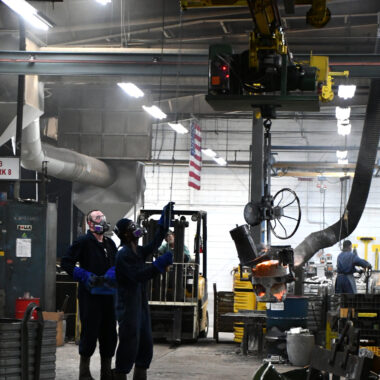Revolutionize Your Manufacturing with Aluminum Casting Innovations
Revolutionize Your Manufacturing with Aluminum Casting Innovations
Blog Article
Dive Into the World of Light Weight Aluminum Spreading: Understanding the Different Approaches
Light weight aluminum spreading is a basic process in the manufacturing sector, with different techniques utilized to develop precise and elaborate components. From the conventional sand spreading approach to the innovative die casting procedure, each approach provides special benefits depending on the requirements of the job.
Sand Casting Approach
Sand spreading, a widely-used method in aluminum casting processes, entails producing molds made of compressed sand for pouring molten metal. When the mold and mildew is all set, it is safely placed in a flask and molten light weight aluminum is put into the dental caries.
After the steel has cooled and solidified, the sand mold and mildew is broken away to expose the light weight aluminum casting. Sand casting enables the production of complex forms and large components that might be difficult or pricey to produce using other techniques. It is also a lasting technique as the sand can be reused and utilized multiple times, reducing waste in the spreading process.
Long-term Mold Method

One significant advantage of the Irreversible Mold And Mildew Technique is the enhanced dimensional precision it provides. The metal mold and mildew enables tighter resistances and finer information in the final aluminum castings compared to sand spreading methods. This accuracy makes it a favored choice for applications where tight dimensional control is important, such as in the aerospace and auto sectors.

Pass Away Casting Refine

Financial Investment Casting Approach
Using an accuracy spreading approach, Investment Casting Technique includes developing detailed light weight aluminum components by pouring liquified steel right into a ceramic mold and mildew. This process, additionally recognized as lost-wax spreading, begins with the creation of a wax pattern of the preferred part (aluminum casting).
The next action involves putting the molten light weight aluminum right into the ceramic mold. The light weight aluminum fills redirected here up the tooth cavity left by the wax pattern, taking its shape precisely. This approach is preferred for its ability to produce complex shapes with high precision and a smooth surface finish. Financial investment casting is commonly made use of for making parts in sectors where intricate styles and tight tolerances are needed, such as aerospace, auto, and medical equipment. The adaptability and accuracy of the Investment Casting Method make it a valuable technique worldwide of aluminum spreading.
Lost Foam Casting Approach
Having checked out the intricate accuracy of Financial investment Casting Approach, the focus currently article source changes to the innovative method of Lost Foam Spreading in aluminum part production. Lost Foam Casting, additionally understood as evaporative pattern casting, is a contemporary technique where a foam pattern of the desired component is produced and afterwards coated with a refractory product. The coated foam pattern is then buried in sand, and molten light weight aluminum is put into the mold and mildew. As the steel fills up the mold and mildew, the foam vaporizes due to the heat, leaving a clean dental caries in the form of the wanted part.
One of the main benefits of Lost Foam Spreading is its ability to produce complicated forms with intricate information, typically in a single item without the requirement for additional machining. This approach is also understood for its high dimensional precision and smooth surface area coating. In Addition, Lost Foam Casting is a cost-efficient process as it lowers the demand for cores and permits the production of light-weight elements. Regardless of its advantages, Lost Foam Casting requires careful control of the casting procedure to protect against flaws and make hop over to here sure high quality parts.
Verdict
In final thought, aluminum casting uses a variety of approaches such as sand spreading, irreversible mold and mildew technique, die casting, investment casting, and shed foam spreading. Each method has its own advantages and applications, making light weight aluminum casting a flexible and extensively utilized process in different markets. Recognizing the distinctions between these techniques is crucial in selecting one of the most ideal spreading technique for certain manufacturing requirements.
Sand casting, a widely-used method in light weight aluminum spreading procedures, involves creating molds made of compacted sand for pouring liquified steel. aluminum casting.The Permanent Mold Technique, like sand casting, is an additional widespread technique utilized in aluminum casting processes, providing unique benefits in terms of mold reusability and dimensional precision. The steel mold allows for tighter resistances and finer information in the last aluminum castings contrasted to sand spreading approaches. The 2 major types of die casting are cool chamber pass away spreading and hot chamber die casting, each ideal for different types of aluminum alloys.In conclusion, aluminum spreading provides a range of methods such as sand spreading, permanent mold and mildew method, pass away casting, investment spreading, and lost foam casting
Report this page